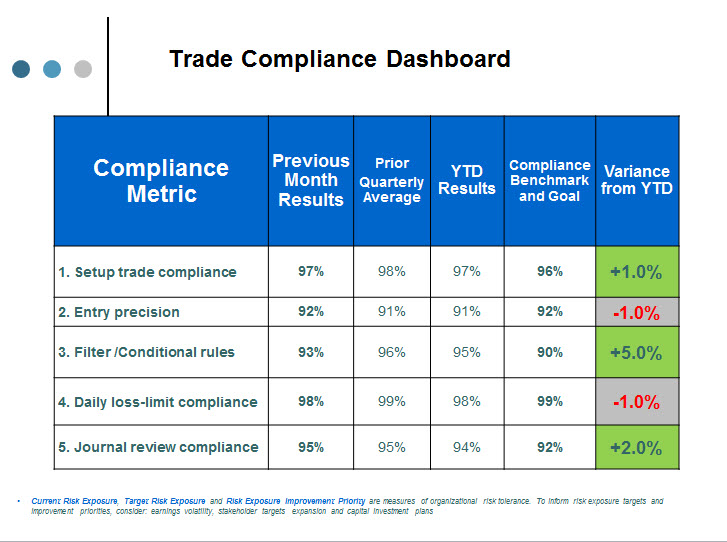For the risk-based trader, compliance — not profits and losses — is the most important metric to track. Compliance simply asks the question, “Have I followed my rules on this trade?” For example, measuring trade-execution compliance will identify the gap between planned trade execution and actual trade execution. In other words, answer the question of whether the trade should have been executed in the first place, and if so, whether you did it correctly.”
Measuring compliance doesn’t have to be a complicated process. Displaying a dashboard-like visual on your workstation is simple way to keep track of the important trade metrics you need to assess. The example in the chart below shows a standard “compliance dashboard.” Notice how the tool displays only key compliance metrics — setup compliance, entry precision, filter/conditional rules, daily loss-limit compliance, and journal review compliance. Such key performance indicators (KPIs) should be measured against benchmarks that reflect a standard of excellence or a personal trading goal. Aggressive traders can raise the expectation bar by setting benchmarks that exceed compliance.

Trade Compliance
This measures whether executed trades come from the valid setups described in your trade plan. Some traders tend to go out of compliance during certain extreme trading days. For example, after a series of winning trades you may roll the dice on some entries because you can “feel” where the market is heading. Conversely, losing mornings are a classic red flag for triggering afternoon non-compliance.
Daily loss-limit compliance
The importance of setting a stop-loss on each trade cannot be overemphasized. However traders rarely wipe out their trading accounts with a single bad trade. Complying with maximum daily or weekly loss limits is an absolute must. If necessary, let your brokerage know about your rule and allow them to automatically shut you down for the day once a threshold is hit. In general, 100-percent compliance with any KPI metric is unrealistic. But this rule is the exception.
Journal compliance
Traders generally love to trade, but it’s easy to get sloppy in this business, especially when “green” is consistently hitting your account. Set a compliance measure for reviewing your journal to keep your trade tracking honest. As in any other business, maintaining tight books will
quickly shed light on any deficiencies and help you take corrective action with as little P&L pain as possible.
Try measuring trade results in clusters to reduce such statistical variance. For example, if you average three or four trades per day, you could measure your progress in batches of 30 to 50 trades or every two weeks. This will allow you to better plot your compliance progress and avoid losing confidence after one bad day when you just weren’t up to par.
The end goal is to identify and mitigate exposures in your trade plan. After all, in any risk-management approach, you cannot assess and control risks you don’t identify; thus the importance of bringing trade deficiencies to light via the compliance dashboard. Using such tools will help keep you honest with yourself and react proactively if you start to see your compliance indicators drop. A solid plan must not only be able to track P&L but assets whether you are following your trade plan with optimum precision.
For the past 15 years I have been teaching traders how to become consistently profitable and actually trade for a living. I have put together a free step by step apprenticeship program that will teach you exactly what you need to do to trade successfully. I pull back the curtain of my hedge fund and personal accounts and show you what I'm doing everyday.
Go to this link right now to get free access Click Here.
By Michael Toma
Michael Toma is a certified risk manager and specialist in trading the equity index and futures markets in the U.S. Toma is the author of ‘The Risk of Trading – Mastering the Most Important Element in Financial Speculation’ and is a frequent speaker on the industry trading conference circuit. His first book, released in 2010, titled ‘Trading with Confluence’, provides a first-hand perspective of risk-based trading and the challenges that new traders are forced to overcome.

Good Idea.....actualy either sided ultimate results are purely depended on this stuffs only, which are least attended by players.
Great Insites!.It was mentioned some very importants points .!.The Journal is the best tip ever..Thanks
Nice blog!! I appreciate your way of annotating the points and market very well manner. It made some good points and got many new things. Thanks for sharing.